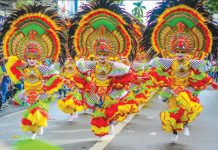
BY DOMINIQUE GABRIEL G. BAÑAGA
AFTER a two-year hiatus brought by the COVID-19 pandemic, Bacolod City again celebrates MassKara Festival, a symbol of the city’s triumph over crisis and tragedies.


However, let us not forget that the MassKara Festival is not the only festival being celebrated in the city; every year Bacolod City also hosts another festival.
The Panaad sa Negros Festival, held in April of each year, celebrates and showcases the culture, cuisine and spirit of the Negrosanons.
“Panaad”, meaning “vow” or “promise” in Hiligaynon, is a form of thanksgiving to the Divine Providence and a commemoration of a vow in exchange for a good life.
The Panaad sa Negros Festival first started as a three-day celebration at the Provincial Capitol Lagoon in 1993 until its first four years.
As it grew, the primary organizers, particularly the Provincial Government of Negros Occidental, thought it was necessary to relocate the event to a more spacious venue.
The festival was then held near the BREDCO port in Bacolod City in 1997, before finally and permanently transferring at the Panaad Park and Stadium in the city’s Barangay Mansilingan in 1998.
Since then, Panaad Park has been likened to the Nayong Pilipino Cultural Park wherein visitors would get the opportunity to have a sneak peak of the 31 towns and cities in Negros Occidental.
The Panaad sa Negros Festival, put on hold in 2020 as part of efforts to combat the COVID-19 pandemic, was supposed to make its return in 2023.
However, as the pandemic ebbs and sensing the opportunity for a faster economic recovery, Victorias City mayor and Association of Chief Executives in Negros Occidental president Javier Miguel “Javi” Benitez came up with the idea to incorporate the Panaad sa Negros Festival to the program of the MassKara Festival, hence the “MassKara sa Panaad” festivities.
Albeit different from the original Panaad sa Negros Festival, the “MassKara sa Panaad” offers an opportunity for closer collaboration between the Provincial Government of Negros Occidental and the City Government of Bacolod.
5 must-visit LGU pavilions during Panaad sa Negros
During the MassKara sa Panaad event, LGU pavilions are certainly worth a visit – and a revisit when the Panaad sa Negros Festival returns in 2023.
They present their culture, interesting places and their unique cuisine.
Taking the 5th spot is Cadiz City. Recently, Cadiz City renovated their pavilion by adding a second floor and a small open space at the side of the structure.


The open space is used as a small area where fishing cooperatives showcase some of the best dried fish products in the country, as well as the ever Filipino favorite, bagoong or fermented fish paste.
The main pavilion, meanwhile, showcases paintings which feature the city’s culture and history such as the city’s Dinagsa Festival celebrated every January.
4th is Talisay City, with its “ancestral house” type pavilion.


Upon entering the pavilion, one is immediately greeted by a mannequin showcasing the city’s Minuluan Festival celebrated every September.
The second floor of the pavilion features the city’s rich history through antique collections, as well as a painting of the burning of the ancestral home of Don Mariano Ledesma Lacson. It is more known today as “The Ruins.”
3rd is Don Salvador Benedicto. The Don Salvador Benedicto pavilion, renovated a few years ago, replaces the old circular wooden structure with a more modern look.
Both side buildings by the entrance are used by farmers’ cooperatives, with fresh produce being sold at reasonable prices.
The second floor look of the pavilion also reminds of the dozens of viewing decks popular with visitors.
Inside the pavilion, one is greeted by a collection of pictures of the town’s breathtaking landscape, as well as mannequins featuring the town’s local festival, the Kali-Kalihan Festival, celebrated every February.
2nd on the list is Sagay City, with its pavilion being recognized as one of the best in the Panaad Park and having been recognized as the “best destination pavilion” for three consecutive years.


A highlight inside is a mural celebrating the city’s rich marine environment.
Just like Cadiz City, Sagay City is also known for its dried fish industry, although they present several other delicacies like Marang Pastillas, as well as turmeric and ginger tea.
The city also celebrates the annual Sinigayan Festival, a thanksgiving event in honor of St. Joseph the Worker, and a celebration of the city’s abundant marine produce.
Sipalay City takes the No. 1 spot. One can already tell just by looking at the pavilion from the outside that the city is a popular beach destination, and it is.


Upon entering, you’ll be greeted by the city’s rich marine culture as well as the local seafood.
This is all thanks to the city’s location, which is also facing the bountiful Sulu Sea.
You’ll also be greeted by the kites used during the annual Burangoy Tourism Kite Festival celebrated in March as part of the city’s charter anniversary.
The fun tour across rich cultures does not end here, as there is something bigger to look forward to. Following the announcement of the provincial government of Panaad sa Negros Festival’s return in 2023, expect a grander celebration as the pandemic gradually winds down./PN







